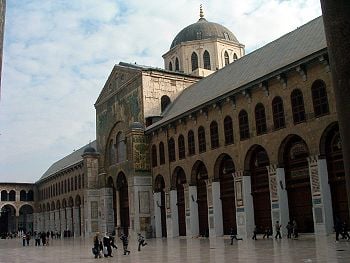Difference between revisions of "Umayyads" - New World Encyclopedia
(adding wiki version) |
|||
| Line 1: | Line 1: | ||
| + | {{Contracted}}{{Status}} | ||
[[Image:Omayyad_mosque.jpg|right|thumb|350px|The Courtyard of the Umayyad Mosque in Damascus, one of the grandest architectural legacies of the Umayyads.]] | [[Image:Omayyad_mosque.jpg|right|thumb|350px|The Courtyard of the Umayyad Mosque in Damascus, one of the grandest architectural legacies of the Umayyads.]] | ||
The '''Umayyad Dynasty''' ([[Arab language|Arabic]] بنو أمية ''banū umayya'' / الأمويون ''al-umawiyyūn'' ; [[Persian language|Persian]] امویان (Omaviyân), [[Turkish language|Turkish]], '''Emevi''') was the first dynasty of [[caliph]]s of the Prophet [[Muhammad]] who were not closely related to Muhammad himself, though they were of the same [[Mecca|Meccan]] tribe, the [[Quraish]]. The first dynasty reigned from AD[[661]] to AD[[750]]. Ironically, the Quraishi clan from which the Umayyads originated had originally been bitter enemies of Muhammad. | The '''Umayyad Dynasty''' ([[Arab language|Arabic]] بنو أمية ''banū umayya'' / الأمويون ''al-umawiyyūn'' ; [[Persian language|Persian]] امویان (Omaviyân), [[Turkish language|Turkish]], '''Emevi''') was the first dynasty of [[caliph]]s of the Prophet [[Muhammad]] who were not closely related to Muhammad himself, though they were of the same [[Mecca|Meccan]] tribe, the [[Quraish]]. The first dynasty reigned from AD[[661]] to AD[[750]]. Ironically, the Quraishi clan from which the Umayyads originated had originally been bitter enemies of Muhammad. | ||
Revision as of 22:10, 28 November 2005
The Umayyad Dynasty (Arabic بنو أمية banū umayya / الأمويون al-umawiyyūn ; Persian امویان (Omaviyân), Turkish, Emevi) was the first dynasty of caliphs of the Prophet Muhammad who were not closely related to Muhammad himself, though they were of the same Meccan tribe, the Quraish. The first dynasty reigned from AD661 to AD750. Ironically, the Quraishi clan from which the Umayyads originated had originally been bitter enemies of Muhammad.
Umayyad rulers
Muawiyah had been the governor of Syria under the 3rd caliph and his kinsman, Uthman ibn Affan. After the assassination of Uthman, he was replaced by the new caliph, Ali ibn Abi Talib. Since the killers of Uthman had allied themselves with Ali, Muawiyah refused to accept his caliphate, and in 657 led an army against him. The two sides agreed to a conciliation procedure, resulting in an arbitration that many of Ali's partsans saw as unfair. The Muslim empire was partitioned. Later when Ali was assassinated in 661, his son Hasan pledged allegiance to Muawiyah and Muawiyah was declared caliph of all Muslim lands. This established the Umayyad dynasty, and the capital of the caliphate was moved to Damascus.
Great waves of expansion occurred under the reign of the Umayyads. Muslim armies pushed across North Africa and Iran, through the late 600s, expanding the borders of the empire from the Iberian peninsula, in the west, to India, in the east. Forces led by Tariq ibn-Ziyad crossed Gibraltar and established Muslim power in the Iberian peninsula, while other armies established power far away in Sind, on the Indian subcontinent. The Muslim empire under the Umayyads was now a vast domain that ruled a diverse array of peoples.
The Umayyads were overthrown in the east by the Abbasid dynasty after their defeat in the Battle of the Zab in 750, following which most of the clan was massacred by the Abbasids. An Umayyad prince, Abd-ar-rahman I, took over the Muslim territory in Al-Andalus (Hispania) and founded a new Umayyad dynasty there.
Umayyad Caliphs at Damascus
- Muawiyah I ibn Abu Sufyan, 661-680
- Yazid I ibn Muawiyah, 680-683
- Muawiya II ibn Yazid, 683-684
- Marwan I ibn Hakam, 684-685
- Abd al-Malik ibn Marwan, 685-705
- al-Walid I ibn Abd al-Malik, 705-715
- Suleiman ibn Abd al-Malik, 715-717
- Umar ibn Abd al-Aziz, 717-720
- Yazid II ibn Abd al-Malik, 720-724
- Hisham ibn Abd al-Malik, 724-743
- al-Walid II ibn Yazid II, 743-744
- Yazid III ibn al-Walid, 744
- Ibrahim ibn al-Walid, 744
- Marwan II ibn Muhammad (ruled from Harran in the [[al-Jazira|Jazira) 744-750
Umayyad Emirs of Cordoba
- Abd ar-Rahman I, 756-788
- Hisham I, 788-796
- al-Hakam I, 796-822
- Abd ar-Rahman II, 822-852
- Muhammad I, 852-886
- al-Mundhir, 886-888
- Abdallah ibn Muhammad, 888-912
- Abd ar-Rahman III, 912-929
Umayyad Caliphs at Cordoba
- Abd ar-Rahman III, as caliph, 929-961
- Al-Hakam II, 961-976
- Hisham II, 976-1008
- Mohammed II, 1008-1009
- Suleiman, 1009-1010
- Hisham II, restored, 1010-1012
- Suleiman, restored, 1012-1017
- Abd ar-Rahman IV, 1021-1022
- Abd ar-Rahman V, 1022-1023
- Muhammad III, 1023-1024
- Hisham III, 1027-1031
Umayyad sahaba
Here is a partial list of the Companions of Muhammad who were part of the Umayyad clan:
- Marwan ibn Al-Hakam
- Muaviya ibn Abu Sufyan
- Abu Sufiyan ibn Harb
Umayyad taba'een
Here is a partial list of the Taba'een (the generation that succeeded the Companions) who were part of the Umayyad clan:
- Abdul Rahman ibn Khalid ibn Walid
- Yazid bin Muawiyah
- Abd al-Malik ibn Marwan
See also
- Umayya ibn Abd Shams
- History of Islam
- Caliphate
External links
- Ummayad Lineage Chart
- http://www.princeton.edu/~batke/itl/denise/umayyads.htm
- Umayyads - First caliphate dynasty
ar:أمويون
de:Umayyaden
es:Dinastía de los Omeyas
fa:امویان
fr:Omeyyades
id:Umayyah
he:בית אומיה
nl:Omajjaden
ja:ウマイヤ朝
pl:Umajjadzi
pt:Omíadas
sv:Umayyader
zh:倭马亚王朝
Credits
New World Encyclopedia writers and editors rewrote and completed the Wikipedia article in accordance with New World Encyclopedia standards. This article abides by terms of the Creative Commons CC-by-sa 3.0 License (CC-by-sa), which may be used and disseminated with proper attribution. Credit is due under the terms of this license that can reference both the New World Encyclopedia contributors and the selfless volunteer contributors of the Wikimedia Foundation. To cite this article click here for a list of acceptable citing formats.The history of earlier contributions by wikipedians is accessible to researchers here:
The history of this article since it was imported to New World Encyclopedia:
Note: Some restrictions may apply to use of individual images which are separately licensed.
